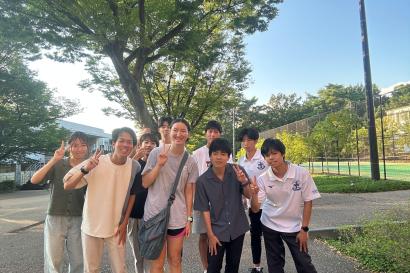Hi everyone,
I’ve been meaning to write about my experience with healthcare while in Japan. While I won’t delve into the details, I will let you know where I have gone and how the process went.
The major distinction between the American and Japanese healthcare systems is that in the U.S. you usually go to a general doctor to be referred to a specialist. You can also go directly to the hospital if you don’t have a general doctor. In Japan, you go to a specialist first. Then you are referred to the hospital if you need further testing or other medical procedures. At least, that’s what I’ve heard and read.
I found that I needed to go to a gynecologist, but I had no idea how to approach the problem. So, I messaged our program coordinator—who we are so lucky to have—and asked if she knew any gynecologists in the area. She did some research for me (THANK YOU!!), and there was a gynecologist right by Nanzan University! She offered to go with me, and I accepted because I was so nervous and anxious.
As a beginner/intermediate Japanese learner, I wasn’t sure I would understand important information. Most students recommend asking a Japanese friend with whom you’d be comfortable sharing your medical concerns to come with you to the doctor. I am grateful that our program coordinator came with me, because my concern required a bit more than basic Japanese to convey.
We went to Ladies Beauty Clinic Yamate located right next to the closest train station to Nanzan University, Yagoto-Nisseki. Our program coordinator had already made an appointment, so we arrived and had to fill out a sheet about my medical history and what my concern was. Unless they have English versions, you definitely need a translator—whether that be a friend or a translating app.
It is very much like a doctor’s visit back in the states. We waited to be called in. After a brief consultation with the gynecologist, I had all the exams done on me. Everything was okay!
It was a very quick visit—something not uncommon in Japan. I usually go in and get out pretty quickly.
If you need a dermatologist, you can also go to Ladies Beauty Clinic Yamate. I do think this clinic is limited for women patients so I think the dermatologist might be available for women only.
I happened to need to go to the dermatologist and the process was pretty similar. This time I went alone. The receptionists were understanding and helpful. They were also patient with my slow Japanese. For the most part, I could understand what they were asking. When I didn’t understand a word, I’d ask them and they’d try to use another word.
The dermatologist was also very understanding and patient. I think if you’re placed in Japanese two at Nanzan, you’re able to understand more than you think. I think going to the dermatologist is easier because you can just point to the problem and describe any issues with it. I wouldn’t go to any other doctor by myself unless they spoke English.
I felt really comfortable going to this clinic and I’d recommend it. I’ll include a link to the clinic’s website at the end. My last note on the clinic is that they spoke some English, which facilitated my solo appointments.
The next doctor I went to was similar to a general care doctor in the U.S. I caught step-throat and I went to the Takigawa Iki-Iki Clinic. It is about 10 minutes away from campus on foot. They have the medical history form in English, so it’s a pretty straightforward process. You fill out the form and write what your symptoms are. Once inside, the doctor was quick to diagnose me and write a prescription. Unlike at the Ladies Beauty Clinic Yamate, they gave me the medicine at the time of payment. The doctor also spoke English, so don’t worry too much about the language barrier.
Finally, I’ve gone to the dentist in Japan. Dental healthcare is covered by the National Health Insurance plan. It was a bit more expensive than the other doctors I went to, but I had a positive experience. I went to an English-speaking dentist that is about 20 minutes away from Nanzan by train. I recommend going here if you’re worried about properly communicating your concerns. You do have to make an appointment, and, if you’re like me, I’d recommend going in person. It makes it a lot easier to clear up misunderstandings and get your point across. The receptionist doesn’t speak English, but she does use a device that translates English to Japanese. The dentist, however, is fluent. She listens to your concerns and will check anything you are worried about!
Overall, I think I’ve had only positive experiences with healthcare here. While this might not be true across the board, I recommend checking these clinics out while you’re here. The prospect of going to the doctor while in another country, whose language you are not fluent in, can be daunting. However, both IES Abroad and CJS are available and willing to provide any support necessary.
One final note:
Every time you go to a new clinic in Japan, that clinic will issue you a card. You should bring this card, alongside your insurance card, with you every time you go because it’s how they identify your file.
Here are the links to each clinics’ websites (that are in Japanese):
Ladies Beauty Clinic Yamate: https://search.10man-doc.co.jp/details/aichi/00219960
Takigawa Iki-Iki Clinic: https://www.ikiiki-cl.com/clinic/menu/index.html
Dentist: http://www.takeda-s.net/mobile/index.html (This link is for the mobile site. It’s the only link I have.)

Lesli Patino
<p>I like rainy days. Once I saw a triple rainbow. I'm just a female Latinx low-income student studying abroad in Japan, learning to navigate an environment completely different from home. Let's get this パン.</p>








